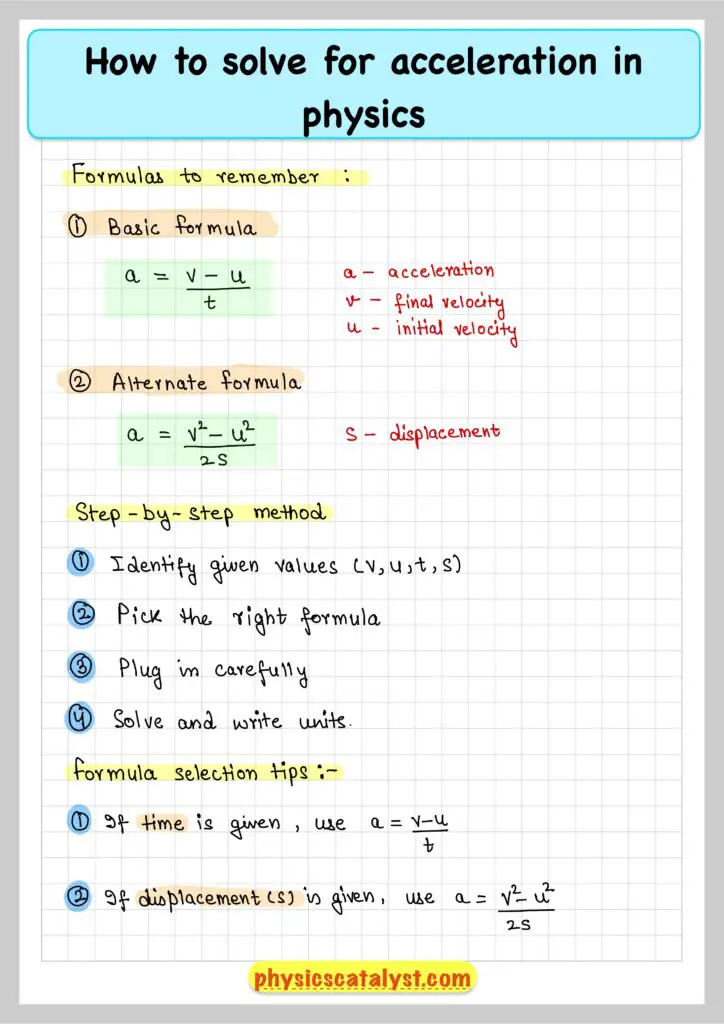Acceleration ($a$) is defined as the rate of change of velocity. It tells you how quickly velocity increases or decreases.
The question ‘How do you solve for acceleration in physics?’ can be answered briefly as follows:
Here, I’ve introduced two formulas—we’ll go through each one step by step, along with a solved example for better understanding.
How to solve for acceleration in physics
Using basic formula for acceleration
$$a = \frac{v – u}{t}$$
This is the most commonly used formula to find acceleration when initial velocity ($u$), final velocity ($v$) and time ($t$) are given.
Where:
- $v$ = final velocity
- $u$ = initial velocity
- $t$ = time taken
Steps to solve for acceleration
(1) Identify given quantities
- Look for values of initial velocity ($u$), final velocity ($v$), and time ($t$). Units must be consistent (m/s for velocity, s for time).
(2) Choose the right formula
Use
$$
a = \frac{v – u}{t}
$$
when you know $u$, $v$ and $t$.
(3) Plug in the values
Substitute the known values carefully.
(4) Solve and include units
Write final acceleration with units (usually $m/s^2$).
Example:
A car increases its speed from 10 m/s to 30 m/s in 5 seconds. Find its acceleration.
Given:
- $u = 10, m/s$
- $v = 30, m/s$
- $t = 5, s$
Putting the values in the formula:
$$
a = \frac{v – u}{t} = \frac{30 – 10}{5} = \frac{20}{5} = 4\, m/s^2
$$
So, the car accelerates at $4, m/s^2$.
Other situations: using equations of motion
This formula is used when you don’t have time but have distance ($s$) over which the velocity changes.
$$
v^2 = u^2 + 2as
$$
Rearrange to solve for $a$:
$$
a = \frac{v^2 – u^2}{2s}
$$
Example:
A bike slows down from 20 m/s to 10 m/s over a distance of 50 m. Find its acceleration.
Given:
- $u = 20, m/s$
- $v = 10, m/s$
- $s = 50, m$
Putting the values:
$$
a = \frac{v^2 – u^2}{2s} = \frac{(10)^2 – (20)^2}{2 \times 50} = \frac{100 – 400}{100} = \frac{-300}{100} = -3\, m/s^2
$$
Here, the negative sign indicates deceleration, meaning the bike is slowing down.
Summary Table
| Known quantities | Use formula |
|---|---|
| $u, v, t$ | $a = \frac{v-u}{t}$ |
| $u, v, s$ | $a = \frac{v^2-u^2}{2s}$ |
| $u, a, t$ to find $v$ | $v = u + at$ |
| $u, a, s$ to find $v$ | $v^2 = u^2 + 2as$ |
Conclusion
So whenever you get a problem on acceleration, first look at what quantities are given — velocity and time, or velocity and distance. Then simply pick the right formula:
- Use $\displaystyle a = \frac{v – u}{t}$ if time is given.
- Use $\displaystyle a = \frac{v^2 – u^2}{2s}$ if distance is given.
With this method, solving for acceleration becomes very straightforward.


